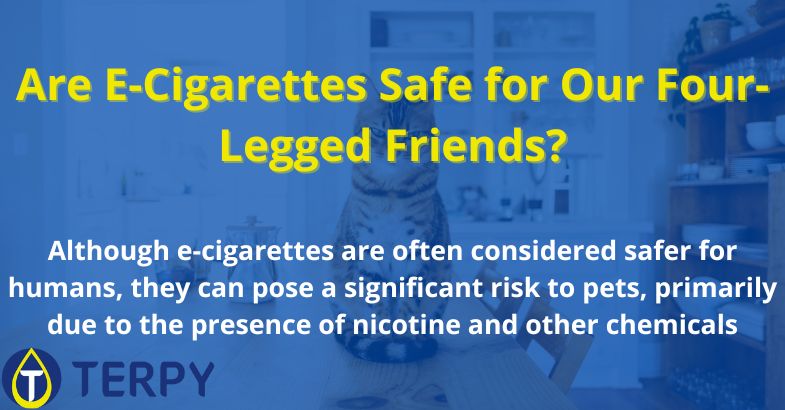Published on: 11/10/2024
Although e-cigarettes are often considered safer for humans, they can pose a significant risk to pets, primarily due to the presence of nicotine and other chemicals
In this article, we will explore in detail the various precautions pet owners should take to protect their furry friends from the potential risks associated with e-cigarette use and exposure to nicotine, e-liquid, and vapor. Finally, we will provide tips on what to do if a pet is exposed to these substances.
Nicotine: A Danger to Pets
Nicotine is highly toxic to pets, even in very small amounts. Unlike humans, who can tolerate higher doses of nicotine, dogs, cats, and other small animals can experience poisoning from even minimal exposure. The liquid in e-cigarettes, known as e-liquid or e-juice, often contains nicotine concentrations that can range from a few milligrams to much higher levels, sufficient to cause serious health problems in animals.
Symptoms of nicotine poisoning in pets can appear quickly and include:
- Vomiting and diarrhea
- Excessive drooling
- Tremors and seizures
- Increased heart rate
- Weakness
- Difficulty breathing
In some cases, nicotine poisoning can lead to death if not treated promptly. For this reason, it is essential for pet owners to exercise extreme caution when handling e-cigarette liquids and to store these products in safe places, out of reach of pets.
Read also: How to Choose the Best E-Cigarette Kit for Beginners


Another Danger: E-Liquids
In addition to nicotine, e-cigarette liquids contain a range of other chemicals that can be hazardous to pets. These liquids may include flavors, vegetable glycerin (VG), and propylene glycol (PG), each with potential health risks for animals. Although these ingredients are generally considered safe for human use, their effects on pets can be quite different.
Propylene glycol, in particular, can be problematic for cats. This chemical, commonly used as a humectant in e-cigarette liquids, has been associated with a condition called Heinz body anemia in cats, which damages red blood cells and can lead to serious health issues.
In addition to the risks from ingestion, there is also the possibility that a pet could be exposed to these liquids through their skin. For example, dogs might lick a liquid that accidentally spills onto a surface, absorbing it through their mouth’s mucous membranes. Direct contact with the skin can also cause irritation or allergic reactions in some animals.
Vapor and Passive Exposure
Another often-overlooked aspect is the effect of e-cigarette vapor on pets. Although it doesn’t contain the same levels of toxic chemicals as traditional cigarette smoke, e-cigarette vapor can still contain nicotine and other substances that can be harmful if inhaled by animals.
Pets have a much more sensitive respiratory system than humans. For example, cats are particularly vulnerable to respiratory issues from exposure to volatile chemicals. Even passive inhalation of vapor can cause symptoms such as coughing, difficulty breathing, and irritation of the airways.
To minimize risk, it’s important not to vape in enclosed spaces where pets are present. This is especially crucial in small, poorly ventilated areas where vapor can accumulate and create a hazardous environment for animals. In addition to nicotine, the flavors in the vapor can also cause respiratory irritation and other adverse reactions in pets.


Safe Storage and Disposal of E-Cigarette Products
E-cigarette liquids should always be stored in airtight, shock-resistant containers and kept out of reach of pets. Batteries and the devices themselves can also pose a danger if ingested, so it is important to keep them in secure places.
Disposal of e-cigarette products requires special care. Never throw away used liquids or devices in places accessible to pets, such as household trash bins. Residual liquids can leak and become easily accessible to curious animals, posing a risk of accidental ingestion. Instead, dispose of leftover liquids according to local hazardous waste regulations, and ensure that electronic devices are properly disposed of to avoid risks of poisoning or injury.
What to Do in Case of Accidental Exposure
Despite all precautions, an animal may accidentally be exposed to liquids for e-cigarette or vapor. In such cases, prompt action is crucial to prevent serious consequences.
If you suspect that your pet has ingested nicotine or been exposed in some way, contact a veterinarian or an animal poison control center immediately. It’s important to provide the vet with all available information, such as the amount of liquid ingested, nicotine concentration, and observed symptoms.
In the meantime, try to keep the pet calm and under observation. If possible, avoid letting the pet drink or eat until you’ve spoken with a veterinarian, as some substances can be absorbed more quickly with food or water. In some cases, the vet may advise inducing vomiting, but this should only be done under professional guidance, as it can sometimes worsen the situation.
Read also: Electronic Cigarettes and Young People: Advice for Parents
In Conclusion
E-cigarettes offer a viable alternative for those looking to reduce or eliminate traditional cigarette use. However, it is crucial to be aware of the risks these devices and their components may pose to pets. With the right precautions, it’s possible to minimize these risks and ensure a safe environment for all family members, including our four-legged friends.
In summary, protecting pets from exposure to potentially harmful substances like nicotine requires a combination of awareness, education, and proactive safety practices. With a bit of attention and care, you can continue to use e-cigarettes, such as those sold at Terpy, without compromising the well-being of the pets that share our daily lives.





